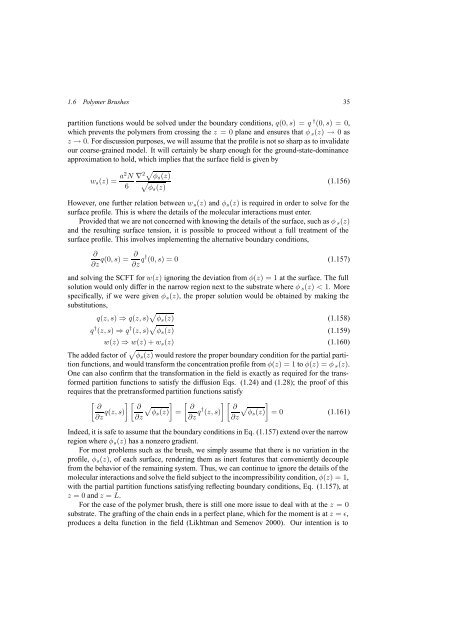Self-Consistent Field Theory and Its Applications by M. W. Matsen
Self-Consistent Field Theory and Its Applications by M. W. Matsen
Self-Consistent Field Theory and Its Applications by M. W. Matsen
You also want an ePaper? Increase the reach of your titles
YUMPU automatically turns print PDFs into web optimized ePapers that Google loves.
1.6 Polymer Brushes 35<br />
partition functions would be solved under the boundary conditions, q(0,s)=q † (0,s)=0,<br />
which prevents the polymers from crossing the z =0plane <strong>and</strong> ensures that φ s (z) → 0 as<br />
z → 0. For discussion purposes, we will assume that the profile is not so sharp as to invalidate<br />
our coarse-grained model. It will certainly be sharp enough for the ground-state-dominance<br />
approximation to hold, which implies that the surface field is given <strong>by</strong><br />
w s (z) = a2 N<br />
6<br />
∇ 2√ φ s (z)<br />
√<br />
φs (z)<br />
(1.156)<br />
However, one further relation between w s (z) <strong>and</strong> φ s (z) is required in order to solve for the<br />
surface profile. This is where the details of the molecular interactions must enter.<br />
Provided that we are not concerned with knowing the details of the surface, such as φ s (z)<br />
<strong>and</strong> the resulting surface tension, it is possible to proceed without a full treatment of the<br />
surface profile. This involves implementing the alternative boundary conditions,<br />
∂<br />
∂z q(0,s)= ∂ ∂z q† (0,s)=0 (1.157)<br />
<strong>and</strong> solving the SCFT for w(z) ignoring the deviation from φ(z) =1at the surface. The full<br />
solution would only differ in the narrow region next to the substrate where φ s (z) < 1. More<br />
specifically, if we were given φ s (z), the proper solution would be obtained <strong>by</strong> making the<br />
substitutions,<br />
q(z,s) ⇒ q(z,s) √ φ s (z) (1.158)<br />
q † (z,s) ⇒ q † (z,s) √ φ s (z) (1.159)<br />
w(z) ⇒ w(z)+w s (z) (1.160)<br />
The added factor of √ φ s (z) would restore the proper boundary condition for the partial partition<br />
functions, <strong>and</strong> would transform the concentration profile from φ(z) =1to φ(z) =φ s (z).<br />
One can also confirm that the transformation in the field is exactly as required for the transformed<br />
partition functions to satisfy the diffusion Eqs. (1.24) <strong>and</strong> (1.28); the proof of this<br />
requires that the pretransformed partition functions satisfy<br />
[ ][ ] [ ][ ]<br />
∂ ∂<br />
∂z q(z,s) √ ∂ ∂ √<br />
φs (z) =<br />
∂z<br />
∂z q† (z,s) φs (z) =0 (1.161)<br />
∂z<br />
Indeed, it is safe to assume that the boundary conditions in Eq. (1.157) extend over the narrow<br />
region where φ s (z) has a nonzero gradient.<br />
For most problems such as the brush, we simply assume that there is no variation in the<br />
profile, φ s (z), of each surface, rendering them as inert features that conveniently decouple<br />
from the behavior of the remaining system. Thus, we can continue to ignore the details of the<br />
molecular interactions <strong>and</strong> solve the field subject to the incompressibility condition, φ(z) =1,<br />
with the partial partition functions satisfying reflecting boundary conditions, Eq. (1.157), at<br />
z =0<strong>and</strong> z = L.<br />
For the case of the polymer brush, there is still one more issue to deal with at the z =0<br />
substrate. The grafting of the chain ends in a perfect plane, which for the moment is at z = ɛ,<br />
produces a delta function in the field (Likhtman <strong>and</strong> Semenov 2000). Our intention is to
















